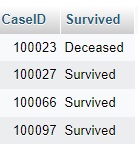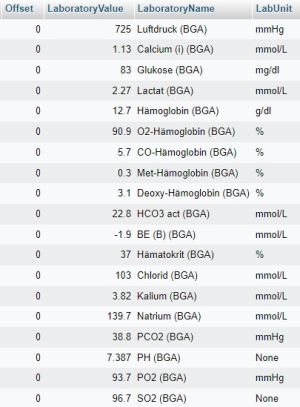Difference between revisions of "SQL Examples"
| Line 1: | Line 1: | ||
While the SICdb dataset is provided as csv raw data, it is designed to be used in a a relational database management system. Refer to [[Get Started]] for further information building up the database and corresponding software. Our software | While the SICdb dataset is provided as csv raw data, it is designed to be used in a a relational database management system. Refer to [[Get Started]] for further information building up the database and corresponding software. Our software includes hundreds of configurable one-click SQL snippets like creatinine on day one/two/..., max/min/average lactate and much more. | ||
Revision as of 16:50, 3 November 2022
While the SICdb dataset is provided as csv raw data, it is designed to be used in a a relational database management system. Refer to Get Started for further information building up the database and corresponding software. Our software includes hundreds of configurable one-click SQL snippets like creatinine on day one/two/..., max/min/average lactate and much more.
Using Referenced Fields
One of the most important tasks is decoding the referenced fields. While our Software does this automatically the database design makes it also quite simple in raw SQL code.
Simple Join Query
SELECT CaseID, d_references.ReferenceValue as Survived FROM `cases` LEFT JOIN d_references ON d_references.ReferenceGlobalID=cases.HospitalDischargeType;
Join Query including Unit-Of-Measurement
SELECT caseID,Offset,LaboratoryValue,d_references.ReferenceValue as LaboratoryName, d_references.ReferenceUnit as LabUnit FROM `laboratory` LEFT JOIN d_references ON d_references.ReferenceGlobalID=laboratory.LaboratoryID;
Subquery Examples
A quite flexible query solution are subqueries. These allow better configuration for the field. Note this is a MySQL 8.x query and may need to be adapted in other database systems. These SQL code snippets have been generated by our software.
Select Maximum Creatinine Example
SELECT `cases`.`CaseID` AS CaseID ,( SELECT Max(laboratory.LaboratoryValue) FROM laboratory WHERE laboratory.CaseID = cases.CaseID AND laboratory.LaboratoryID = 367 AND Offset >= 0 AND Offset < 7 * 86400 ) AS MaximumCreatinineInFirstWeek FROM cases
Select First Creatinine Example
SELECT `cases`.`CaseID` AS CaseID ,( SELECT laboratory.LaboratoryValue AS val FROM laboratory WHERE laboratory.CaseID = cases.CaseID AND laboratory.LaboratoryID = 367 AND Offset >= 0 ORDER BY laboratory.Offset ASC LIMIT 0 ,1 ) AS FirstCreatinineAfterAdmission FROM cases
Select Second Creatinine Example
SELECT `cases`.`CaseID` AS CaseID ,( SELECT laboratory.LaboratoryValue AS val FROM laboratory WHERE laboratory.CaseID = cases.CaseID AND laboratory.LaboratoryID = 367 AND Offset >= 0 ORDER BY laboratory.Offset ASC LIMIT 1 ,1 ) AS SecondCreatinineAfterAdmission FROM cases
Select Second Creatine With Time Example
A little more advanced example including the time-of-measurement.
SELECT `cases`.`CaseID` AS CaseID ,( SELECT laboratory.LaboratoryValue AS val FROM laboratory WHERE laboratory.CaseID = cases.CaseID AND laboratory.LaboratoryID = 367 AND Offset >= 0 ORDER BY laboratory.Offset ASC LIMIT 1 ,1 ) AS SecondCreatinineAfterAdmission ,( SELECT laboratory.Offset AS val FROM laboratory WHERE laboratory.CaseID = cases.CaseID AND laboratory.LaboratoryID = 367 AND Offset >= 0 ORDER BY laboratory.Offset ASC LIMIT 1 ,1 ) / 3600 AS HoursAfterAdmission FROM cases


